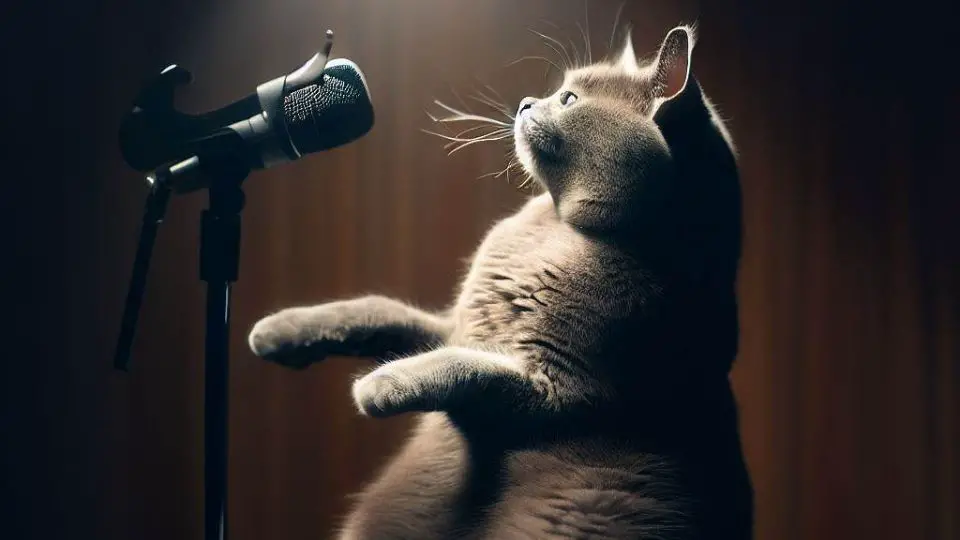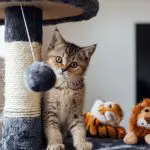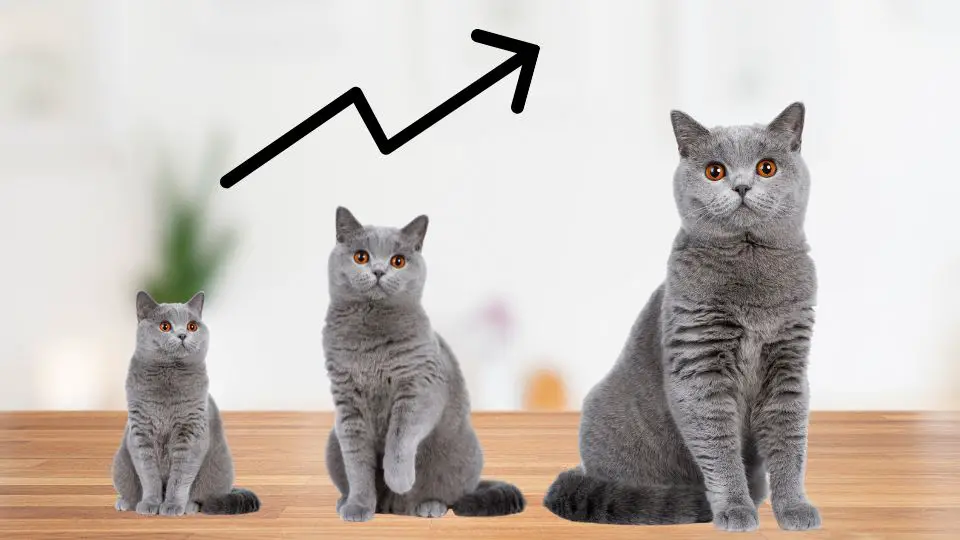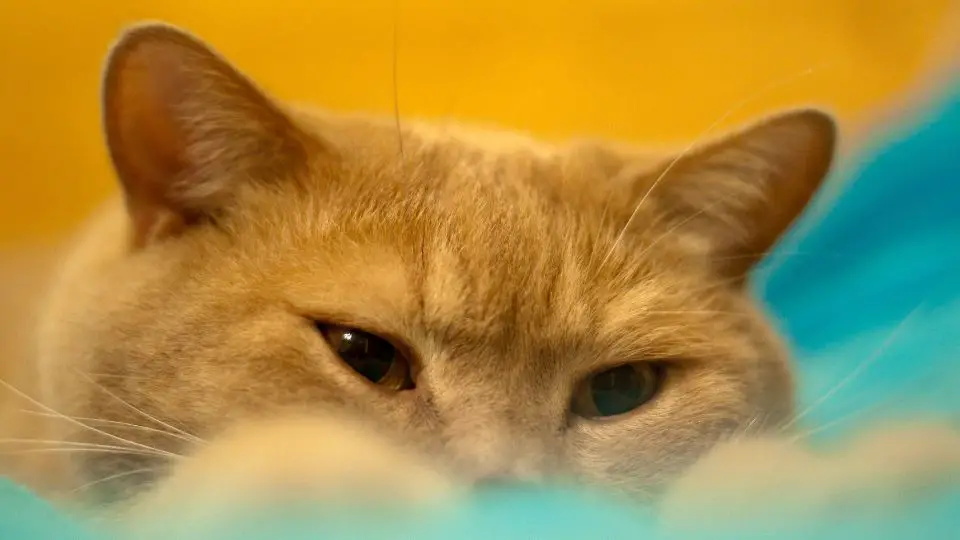The heat cycle, also known as estrus, is a natural reproductive process that female cats go through.
If you’re a proud owner of a British Shorthair cat, understanding their heat cycle can help you provide appropriate care and manage any related behaviors.
In this article, we will delve into the heat cycle of British Shorthairs, discussing its duration, signs, and helpful tips for supporting your cat during this time.
Understanding the British Shorthair Breed
The British Shorthair is a medium to large-sized cat breed with a solid build and a dense, plush coat. They have round faces with full cheeks, expressive eyes, and small, rounded ears. This breed is known for its stocky and muscular physique, giving them a robust and sturdy appearance.
British Shorthairs have a variety of coat colors and patterns, ranging from the classic blue (gray) to silver, golden, tortoiseshell, and more. Their dense and plush coat requires minimal grooming and contributes to their distinct charm.
When it comes to the heat cycle of British Shorthairs, there are a few unique characteristics and traits to consider. Firstly, British Shorthairs tend to have a later onset of sexual maturity compared to some other breeds. While the average age for a female cat to reach sexual maturity is around six to nine months, British Shorthairs may take a bit longer, usually around nine to twelve months.
Additionally, British Shorthairs are known for their calm and reserved nature, which can sometimes be reflected in their behavior during heat. They may not display the same level of restlessness or vocalization as some other breeds. However, each individual cat’s behavior can vary, and some British Shorthairs may still exhibit signs of heat, such as increased affection, restlessness, or spraying behavior.
Note that the heat cycle in British Shorthairs is a natural part of their reproductive cycle. Responsible pet owners often opt for spaying or neutering their cats to prevent unwanted pregnancies and potential health issues. Discussing this decision with a veterinarian is crucial to ensure the best course of action for your British Shorthair’s well-being.
Signs and Symptoms of Heat in British Shorthairs
When a British Shorthair cat goes into heat, there are certain signs and symptoms that you can look out for. Understanding these signs can help you recognize when your cat is in heat and respond accordingly. Here are some common signs and symptoms of heat in British Shorthairs:
- Vocalization: One of the most noticeable signs of a cat in heat is increased vocalization. Your British Shorthair may become more vocal and make distinctive mating calls to attract potential mates.
- Restlessness and Agitation: Cats in heat may exhibit restlessness and become more agitated. They may pace, roll on the floor, or exhibit restless behavior in an attempt to seek a mate.
- Increased Affection: While British Shorthairs are generally known for their calm and independent nature, during heat, they may become more affectionate. They may rub against objects, furniture, or even their owners to mark their territory and show their availability for mating.
- Spraying: In my experience, female British Shorthairs in heat may display spraying behavior, where they release a strong-smelling urine to attract male cats. This behavior is a way for them to mark their territory and signal their readiness to mate.
- Increased Fertility: British Shorthairs have a high fertility rate during heat. Female cats can become pregnant easily during this time, so it’s important to keep them indoors and prevent any unwanted mating.
- Physical Changes: Physically, you may notice changes in your cat’s behavior. Females may exhibit a “lordosis” posture, where they raise their hind end and lower their front end to display their receptiveness to mating. Male cats may become more attentive, show increased interest in the female, and exhibit mounting behavior.
Note that each cat may exhibit slightly different signs during heat, and the intensity and duration of heat cycles can vary. If you notice any unusual or concerning behavior, it’s always a good idea to consult with your veterinarian for guidance and advice.
Duration and Frequency of the Heat Cycle
While individual cats may have variations, there are some general guidelines to consider regarding the heat cycle of British Shorthairs:
- Duration of Heat Cycle: The heat cycle, also known as estrus, typically lasts around 4 to 7 days. During this time, female British Shorthairs are fertile and receptive to mating.
- Frequency of Heat Cycles: British Shorthairs, like many other cat breeds, are polyestrous, which means they can go into heat multiple times throughout the year. On average, they may experience heat cycles every 2 to 3 weeks during the breeding season, which typically occurs from spring to early fall.
Note that the length and frequency of heat cycles can vary from cat to cat. Some British Shorthairs may have shorter or longer cycles, while others may have irregular cycles. Factors such as age, health, and environmental conditions can influence the duration and frequency of heat cycles.
As a cat owner, you should be aware of your British Shorthair’s heat cycle patterns. This knowledge can help you anticipate and prepare for their behavior and needs during this time. If you have an intact female cat and do not plan to breed her, considering spaying her can help prevent unwanted pregnancies and eliminate the need to manage her heat cycles.
Heat Cycle Management
Spaying or neutering your British Shorthair cat is crucial to prevent unwanted pregnancies. During heat cycles, female cats can become fertile and seek mating opportunities, which may lead to unwanted litters of kittens. By opting for spaying (for females) or neutering (for males), you can eliminate the risks of unplanned pregnancies and contribute to population control.
Health Benefits of Spaying/Neutering:
Spaying or neutering your British Shorthair cat provides numerous health benefits, both for females and males.
- Females: Spaying female cats eliminates the heat cycles, preventing the associated behaviors such as restlessness, yowling, and spraying to attract males. Additionally, spaying significantly reduces the risk of uterine infections (pyometra) and minimizes the chances of mammary gland tumors, particularly if the procedure is done before the first heat cycle.
- Males: Neutering male cats helps manage their reproductive behavior, including urine marking and aggressive tendencies. It also reduces the risk of testicular cancer and lowers the likelihood of certain urinary tract issues, such as urinary blockages and infections.
Coping with Heat Behavior
Dealing with a British Shorthair cat in heat can present unique challenges for pet owners. The behavioral changes and increased attention-seeking can be overwhelming if you’re not prepared. Here are some practical tips for coping with heat behavior and my insights based on my experience with British Shorthairs.
Tips for Managing a British Shorthair in Heat
- Provide Extra Attention and Playtime: During the heat cycle, British Shorthairs may exhibit increased restlessness and seek more attention from their owners. Offering extra affection, playtime, and interactive toys can help redirect their energy and provide mental stimulation.
- Create a Calm Environment: British Shorthairs in heat may become more vocal and exhibit heightened levels of anxiety. Create a calm and soothing environment by providing cozy hiding spots, comfortable bedding, and minimizing loud noises or disruptions.
- Use Pheromone Sprays or Diffusers: Consider using pheromone sprays or diffusers designed specifically for calming cats. These products release synthetic pheromones that mimic the natural comforting scents produced by mother cats, helping to reduce anxiety and stress.
Insights into Heat Behavior
- Increased Vocalization: During heat, British Shorthairs may vocalize more frequently and loudly. This behavior serves as a means to attract potential mates. Be prepared for intense meowing or yowling, which can be quite persistent during this time.
- Heightened Affection and Rubbing: British Shorthairs in heat may display increased affectionate behaviors such as rubbing against objects or people. This behavior is their way of marking territory and signaling their availability for mating.
- Agitated Behavior: Some British Shorthairs may exhibit more aggressive or restless behavior during heat. They may show signs of irritability, become more territorial, or engage in excessive grooming. Providing outlets for play, such as interactive toys or puzzle feeders, can help alleviate their pent-up energy and prevent destructive behaviors.
Conclusion
Understanding the heat cycle of your British Shorthair cat is crucial for providing appropriate care and managing their behaviors. By recognizing the signs, being prepared for the duration and frequency of their cycles, and considering spaying or neutering as a preventive measure, you can ensure the well-being of your cat and maintain a harmonious environment in your home.
Remember, each cat is unique, and their experiences may vary, so consult with a veterinarian for personalized advice and recommendations. With knowledge and proactive care, you can support your British Shorthair through their heat cycles and strengthen the bond you share.







